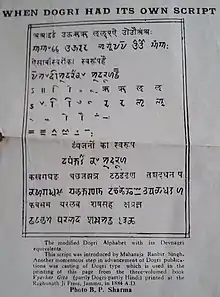Dogri script
The Dogri script, also known as the Name Dogra Akkhar script (Dogri: नमें डोगरा अक्खर, ISO: Namēṁ Ḍōgrā Akkhar, Dogri pronunciation: [nəmẽː ɖoːgɾaː əkːʱəɾ], lit. "new Dogra letters/symbols") is a writing system originally used for writing the Dogri language in Jammu and Kashmir in the northern part of the Indian subcontinent.[1]
| Dogri script 𑠝𑠢𑠳𑠷 𑠖𑠵𑠌𑠤𑠬 𑠀𑠊𑠹𑠋𑠤 | |
|---|---|
 | |
| Script type | |
| Direction | left-to-right |
| Region | Jammu |
| Languages | Dogri |
| Related scripts | |
Parent systems | |
Sister systems | Takri, Gurmukhī |
| ISO 15924 | |
| ISO 15924 | Dogr (328), Dogra |
| Unicode | |
Unicode alias | Dogra |
| U+11800–U+1184F | |
| Brahmic scripts |
|---|
| The Brahmi script and its descendants |

History
Name Dogra Akkhar was created by the order of Maharaja Ranbir Singh of Jammu and Kashmir.[2] It is a modified version of the old Dogra Akkhar script, which in turn was a Jammu variant of the Takri script.

Efforts of revival
Signboards in Name Dogra Akkhar were erected at Jammu Tawi railway station.[3] However, the script is functionally extinct, with Devanagari being used to write Dogri now.
Unicode
Name Dogra Akkhar was added as a Unicode block to the Unicode Standard in June, 2018 (version 11.0).[4]
The Unicode block is named Dogra, at U+11800–U+1184F, and contains 60 characters:
| Dogra[1][2] Official Unicode Consortium code chart (PDF) | ||||||||||||||||
| 0 | 1 | 2 | 3 | 4 | 5 | 6 | 7 | 8 | 9 | A | B | C | D | E | F | |
| U+1180x | 𑠀 | 𑠁 | 𑠂 | 𑠃 | 𑠄 | 𑠅 | 𑠆 | 𑠇 | 𑠈 | 𑠉 | 𑠊 | 𑠋 | 𑠌 | 𑠍 | 𑠎 | 𑠏 |
| U+1181x | 𑠐 | 𑠑 | 𑠒 | 𑠓 | 𑠔 | 𑠕 | 𑠖 | 𑠗 | 𑠘 | 𑠙 | 𑠚 | 𑠛 | 𑠜 | 𑠝 | 𑠞 | 𑠟 |
| U+1182x | 𑠠 | 𑠡 | 𑠢 | 𑠣 | 𑠤 | 𑠥 | 𑠦 | 𑠧 | 𑠨 | 𑠩 | 𑠪 | 𑠫 | 𑠬 | 𑠭 | 𑠮 | 𑠯 |
| U+1183x | 𑠰 | 𑠱 | 𑠲 | 𑠳 | 𑠴 | 𑠵 | 𑠶 | 𑠷 | 𑠸 | 𑠹 | 𑠺 | 𑠻 | ||||
| U+1184x | ||||||||||||||||
| Notes | ||||||||||||||||
References
- Pandey, Anshuman (2015-11-04). "L2/15-234R: Proposal to encode the Dogra script" (PDF).
- Gupta, Veena (2020). Dogri Vyakaran (in Dogri) (5th ed.). Bari Brahmana, Jammu: J&K Academy of Art, Culture & Languages.
- SNS (2018-05-04). "Dogri script finds place on signposts at Jammu railway station". The Statesman. Retrieved 2022-10-20.
- "Unicode 11.0.0". Unicode Consortium. June 5, 2018. Retrieved June 5, 2018.